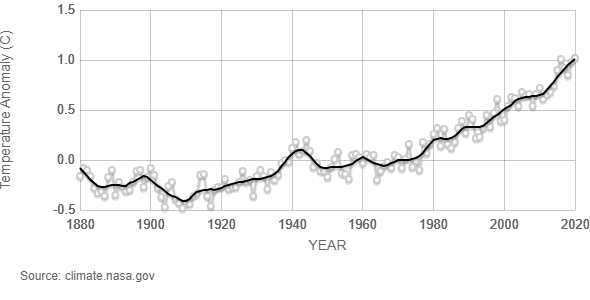“That is the question.
– a poor adaptation of Shakespeare’s Hamlet
Whether ’tis easier to ignore and suffer
The heat and cold of unpredictable future
Or to put life and money against the unwavering force,
And make a chance for my past to redeem?”
What is decarbonisation?
Decarbonisation is the process of reducing human-made greenhouse gas (GHG) emissions. Based on scientific evidence, there are a bunch of gases in the atmosphere that can cause what is known as global warming. Out of these gases – carbon dioxide (CO2), methane (CH4) and nitrous oxide (N2O) – CO2 accounts for more than two-thirds.
Why do we need to change?
Global warming, or the steady increase of mean global temperature, is well established and has been very dramatic since the early last century. GHG plays a pivotal role in warming and the associated changes in weather patterns (known as climate change). It is well-established by observations and through various climate models. The plot below shows the mean change in global temperature since 1880 (taken from NASA’s Global Climate Change page).

As per ClimateWatch, human activities are responsible for about 47 billion tonnes of CO2 equivalent in 2018, and 34 billion (73%) of it is from the energy sector. The remainder is predominantly agriculture and land usage.
Who can make a difference?
While the world needs to unite to manage GHG emissions, three sectors in the energy bucket hold the key to success. The top three sectors that account for approximately 80% of the energy consumers are industry (29% or 120 million TeraJoules), transportation (29%) and residential (21%) (based on 2019 data from the International Energy Agency (IEA)). Carbon-based fuels (oil, gas and coal) supply 80% of this energy.
How can we change?
There are a few options ready in the development funnel. The first one is using electricity as the primary vehicle for energy supply. And the electricity may come from renewables (wind, solar, hydro, geothermal), nuclear, and even carbon-based fuel with carbon capture and storage. The last option may work during transition, with a systematic plan to move away. Wherever storage is required, batteries and hydrogen (produced from water and electricity) come in handy.
What are the challenges?
The first one that comes to mind is cost, especially for the industrial and transportation sectors. The fundamental driver for it to change is when the replacement’s total cost (capital and operation) is lower than the operating cost of the existing technology. Costs usually come down when there is production on a sufficient scale. However, here is a chicken and egg problem – higher costs prohibit the scale, and costs can not come down when the scales are low; it is the right time for the government to intervene through mandates and incentives.
Then comes infrastructure and affordability for electrification; both affect the transportation sector. The easy part is to produce electricity, followed by storage. Batteries help smaller vehicles but not the larger ones – the trucks, ships and aircraft. So, you require a different solution. The transformation of smaller vehicles also has its challenges. How will you provide incentives to a billion pieces of equipment spread all over the planet – be it charging points or simply the financial means to procure an electric vehicle?
The last sector is residential. You may think it was the easiest to change based on the public outcry to stop global warming. I will argue that it is the most difficult to change. First, like the case with cars, buildings are spread all over the world. Unlike automobiles, they are more expensive to change and even more difficult to convince that part of the problem is just in my backyard.
Further Reading
[1] Global trends temperature: NASA Page
[2] Energy Supply and Production: IEA
[3] GHG Emissions: ClimateWatch
[4] What three degrees of global warming look like: The Economist

